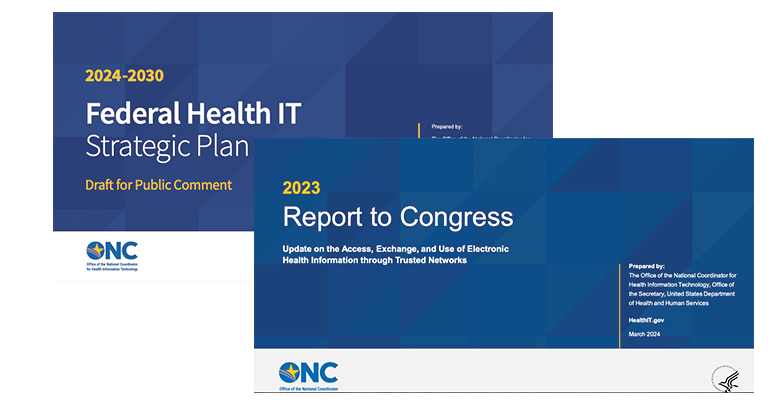 In March 2024 the Office of the National Coordinator for Health Information Technology (ONC) released two reports. The first was the 2024-2030 Federal Health IT Strategic Plan which was released for public comment. This plan does not appear to be substantially different from past plans. The needs of public health are articulated along with other issues. The first goal of the plan – Promote Health and Wellness – has “improving the use of public health data” as one of its strategies, as well as “leveraging public health data to inform action.” Public health and its staff is continually called out to assist in data exchange and health promotion, as is support for public health reporting.
In March 2024 the Office of the National Coordinator for Health Information Technology (ONC) released two reports. The first was the 2024-2030 Federal Health IT Strategic Plan which was released for public comment. This plan does not appear to be substantially different from past plans. The needs of public health are articulated along with other issues. The first goal of the plan – Promote Health and Wellness – has “improving the use of public health data” as one of its strategies, as well as “leveraging public health data to inform action.” Public health and its staff is continually called out to assist in data exchange and health promotion, as is support for public health reporting.
The last goal – Connect the Health System with Health Data – continues to emphasize collaboration between public health and other sectors. The final objective stresses an integrated public health data system and infrastructure enabled by better tools, standards, policies, and workforce development. These goals and objectives are consistent with CDC’s Data Modernization Initiative and the Public Health Infrastructure Grant (PHIG) funding to improve both systems and skills. While these programs will help, funding for core public health systems continues to be in real jeopardy and the use of COVID-19 funding for system improvement will expire in June 2025. Many public health agencies are not able to spend even available funds that quickly on system improvement, and retaining experienced staff feels like a zero-sum game as many public health professionals are leaving service through retirement and sheer exhaustion after fighting the pandemic.
The second report released by ONC is the 2023 Report to Congress: Update on the Access, Exchange, and Use of Electronic Health Information through Trusted Networks (so-called “HITECH Report” as it comes from a statutory requirement from the 2009 HITECH Act). The report largely focuses on ONC’s support for the major initiatives: TEFCA, USCDI, and FHIR. The report also updates statistics on the prevalence of electronic data sharing, barriers to effective data sharing, and awareness of TEFCA. Lots of additional information about TEFCA is also provided as a “new era” in health information sharing. The CDC’s Public Health Data Strategy is called out as one of the initiatives that TEFCA will support.
Once again, nothing really dramatic in this report. From a public health standpoint, ONC is saying all the right things and including public health appropriately. Public health organizations have been active in major initiatives like USCDI (and extensions now being discussed in USCDI+). Agencies and vendors are starting to educate themselves on FHIR and participate in early activities like HL7’s Helios Accelerator Project. While it is less clear how public health can leverage TEFCA in the short run, more focused attention is being placed on this potential, including a widely-attended recent webinar hosted by the Association of State and Territorial Health Officers (ASTHO), “TEFCA Overview and Perspectives from the Field” (April 4, 2024) as well as new TEFCA-Public Health Community of Practice being launched by ONC in April.

